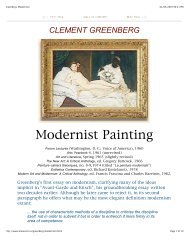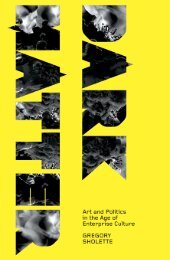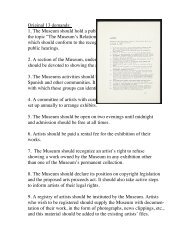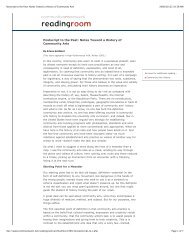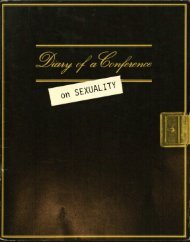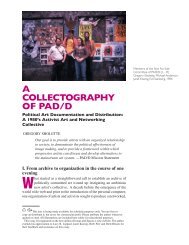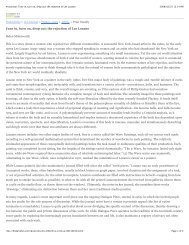Screen - Dark Matter Archives
Screen - Dark Matter Archives
Screen - Dark Matter Archives
Create successful ePaper yourself
Turn your PDF publications into a flip-book with our unique Google optimized e-Paper software.
98 'mainstream cinema', and particular1y the centrality of women tovoyeurism: it involves a fixation which impedes narrative.997 Griselda Pollock.centres on repetition of situations, the display of a star. Fetishism'What's Wrongwi th Images ofis a form of looking which disavows castration and hence sexualWomen', <strong>Screen</strong>difference, whereas voyeurism involves an acknowledgment ofEducation no 24.sexual difference in its attempts to demystify or punish woman a~Autumn 1977 p 30.object of tbe look. In both forms8 'Fetishism' (1927),Standa rd Edition.vol. XXI.9 Althoughaddressed t.ocinema, much ofMulvey's analysisis rclevanr [0still images.that cinema. Through an examination of the forms of looking andtheir pleasures (informed by psychoanalytic theory), Mulvey is ableto give an adequate characterisation of such diverse phenomenaas the star system. strip-tease and the narrative func tion of womenin 'dominant cinema', This characterisation indicates directionsfor film-making practice which try to undermine these forms.However. it seems to he unable to account for and analyse the\\'ays in which current visual pornography is obsessed with \\'omen'sgenitals.Th e directness [of vaginal imagery] radically questions the psychoanalyticallybased analyses of images of women undertaken byClaire Johnston and Laura Mulvey and the nOlions oj castrationfear and the phallic woman. TMulvey's typology includes a notion of fetishism that is basedon the letter of Freud's. text,S taking fetishism as necessarilyinvolving the disavowal of woman's lack of a penis. Hence currentpornography would seem to contradict Mulvey's analysis, althoughin other areas it has proved to be crucial.Mulvey describes cinema as an activity of 100king 9 in whichthree looks ate involved: that of the spectator to the screen; thatof rhe camera to the event; and that of the actors within the eventbetween each other. In classic cinema these are carefully arrangedso that they never coincide: the camera never looks at the space(hat the audience 'occupies' (lhe 180 0rule); the actors neve.r lookdown the axis of the camera . This regime allows the full exploitationof all the 'pre-existing patterns of fas cinarion already at workwithin the individual subject and the social formations that havemoulded him' (p 6). The first is the pleasure in looking itself, thescopophilic drive directed towards submitting others to a controllingand curious gaze. This drive is partly developed into anarcissistic form through which the viewer identifies him/ her selfwith figures perceived as exis ting outside the self of the viewer.Tht:se nNO SlTuctures of looking exist in tension with each other,and are crossed by a furt.her pair of contradictory structuresproduced within the caslration complex: voye urism and fetishism .Vo yeu rism is an active, moblle form, associated with change andnarrativisation. Itdemands a sto ry, depends on making something happen . forcinga c1lange in another person. a battle of will and strengt h, victor),/defeat, all occurring in a linear time u'!;th a beginning and anend (p 14).Fetishism according to Mulvey's account is in contradiction 'A.]thultimately, the mean ing of woman is sexual difference, th e absenceof a penis as visually ascertainable, the material evidence ml whichis based the castration complex essential for the orga nisation ofentrance into the symbolic order and the la w of the father (p 13).Fetishism in Mulvey's account is a disavowal of woman's lack ofa penis. and therefore should always involve avoiding the directsight of the female genitals and finding a substitute penis inparticular fetish objects, or jn the whole figure of the womanmade-phallic.Current pornograpby would seem to refute thjscharacterisation. Yet in eve.ry other respect, current visual pornographymaintains the kind of textual structure that Mulveyassociates with fetishism. It presents the repetition of events ratherthan narrative develo pment towards tbe resolution of an enigma;it relies upon a concentration on the figure of the v,'oman whichlends to oust any other considerations; and 'the image [is] indirect erolic rappon with the spect.::.tor· (ibid p 14).The feri s li c representalion attempts to abolish the distancebetween spectator and representation. Voyeurism installs a separation·of seer and seen as the very principle of irs operation, allowingthe seer a secure posicion ove r and against a representation thatpermjts [he seen to change wi thout threatening the position of theseer. This permits the development of editing. scene dissectionand narrati ve in the cinema. Fetishism constantly anempts toreduce or annul this distance and separation. Hence it is onlycapable of producing an attenuared narnnion, a constant repetitionof scenarios of desire, where the repetition around certain neuralgicpoints outweighs any resolution of a narrative enigma, any discoveryor reordering of facts. At its most extreme, fetishisminvol ves a concemralion upon performance, explici tly posed forthe viewer (sometimes involving the performer looking directly 'at'the audience). or even upon the frame-edge, or rhe two-dimensionalreality of the realist photograph. A fetish ist regime attempts toannul the separation of image and spectator, lO reinsrall animmediate reb lion that promises (in vain) LO pro"ide satisfactionto desire itself.Thus Mulvey's use of the conceprs of "oyeurism and feti shismcontains much tha t is viral (Q a metapsycho)ogical characterisalionof the various modes of cinematic and photograph.ic representation.



